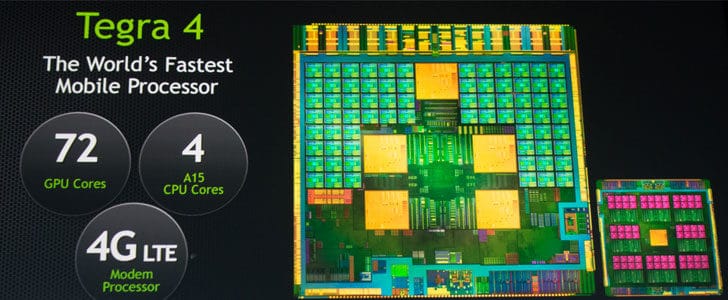Few weeks ago Nvidia released their next mobile platform, Nvidia Tegra 4 in CES. Previously I rounded up rumors about it and finally it came out to be pretty similar.
Let’s go and take look at official spec of Nvidia Tegra 4 and what is its impact on mobile computing.

Technical Specification
CPU
Nvidia Tegra 4 uses latest 28 mm semiconductor architecture and supports up to 4 ARM Cortex A15 1.8 GHz CPU cores. This is a major improvement compared to 40 mm architecture and ARM Cortex A9 CPU cores in Tegra 3.
CPU L1 cache is 32 KB for instructions and another 32 KB for data. L2 cache is 1 MB. It’s still the same as Tegra 3. And yeah, 4-PLUS-1 battery saving technology continues here as well.
GPU
GPU is the major improvement here and it will definitely be good news for mobile gamers. It has 72 cores GeForce GPU. It’s 6 times faster than Tegra 3 and gives you access to latest Tegra Zone mobile games.
Memory
Speed of memory access has gone up to 12.8 GB/s with LPDDR3 technology. This is 2 times improvement compared to Tegra 3.
Connectivity
This has entire previous connectivity features plus 4G LTE and USB 3.0. These will solve major connectivity problems Tegra 3 had.
Application and Possibilities
Currently only device powered with Nvidia Tegra 4 platform is “Project Shield”. In CES it unveiled its beastly gaming performance. It’s good enough evidence for us to figure out how powerful the Tegra 4 platform is. Soon many other devices will come to market with this platform, specially gaming optimized tablets.
Tegra 4 has 4-PLUS-1 technology to save battery power by processing background tasks in a low power consuming CPU core. Tegra 4 is capable of switching off individual CPU cores to save power depending on the work load. Further 28 mm architecture is a major power saver. All together this SoC will be much less power hungry than Tegra 3. So we have a hope for better battery life in future Tegra 4 powered devices.
Wraping Up
True that this is an amazingly powerful mobile computing platform, yet competition is tight. Qualcomm came up with Snapdragon 800 and Samsung has Exynos 5 Octa. As I think, to stand out in the competition Nvidia Tegra 4 should focus on mobile gaming niche where they have better performance, infrastructure and years of experience.
Other than hardware muscle the major success factor would be better power consumption. There Nvidia Tegra 4 might have a advantage with its power saving technologies. However we have to wait till commercial devices come out for us to get a more accurate picture about that.
Tags: #Nvidia #Smartphone #Tablet
